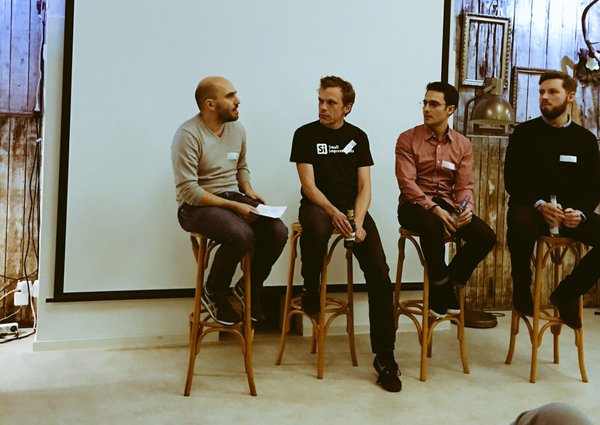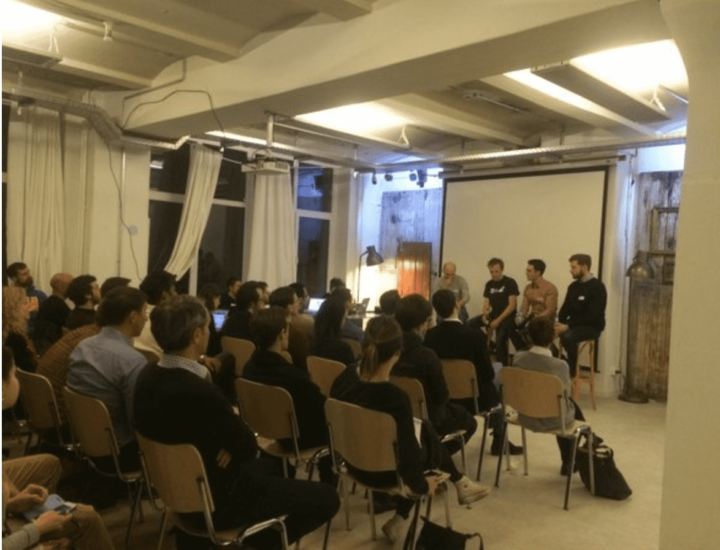On March 21, a variety of Berliner SaaS folks came together for the first Berlin SaaS Meetup, hosted by SaaScribe and SaaStock, and sponsored by Point Nine Capital. We’d say it was a success!
Along with plenty of time for networking and some tasty snacks, the meetup featured a panel discussion with three local Berlin founders:
 Per Fragemann of Small Improvements
Per Fragemann of Small Improvements
 Niklas Jansen of Blinkist
Niklas Jansen of Blinkist
 ChartMogul’s very own Nick Franklin
ChartMogul’s very own Nick Franklin
 and Point Nine Capital co-founder Pawl Chudzinski, who led with questions and later opened the floor to the audience.
and Point Nine Capital co-founder Pawl Chudzinski, who led with questions and later opened the floor to the audience.
Below is a recap of the panel discussion on the meetup’s theme: Growth through retention. Why is it important? What are the challenges? How will you improve it? Plenty nuggets of wisdom herein, as well as cool insight into local Berlin startups and what’s on the mind of the Berlin SaaS community.
“Investors like retention, but they like growth more.” – Niklas Jansen
But how are the two related?
“At some point, expansion business is more lucrative than new business,” said Nick Franklin. “50,000 customers each upgrading a little bit is worth more, and a lot easier to attain, than 50,000 brand new customers.”
The key to getting to that point, where expansion biz is your growth engine, is to retain your customers and let that customer base compound over time. This is growth through retention.
Though customer acquisition is usually the first thing on an early startup’s agenda, the founders agreed that retention becomes more and more critical as your customer count rises.
“Retention drives everything,” said Jansen.
Including customer lifetime value and word-of-mouth. In fact, Jansen shared that at Blinkist, a 10% improvement in retention improved their LTV by 30%! That is huge! (If you want to brush up on your LTV knowledge, check out the Ultimate Guide to SaaS Customer LTV)
The founders monitor retention slightly differently. Small Improvements and Blinkist look mostly at Customer # churn, while ChartMogul follows revenue churn. But when it comes to retention challenges and solutions, there was a lot of commonality. Let’s dive in.

What are some retention-related challenges that you’ve faced?
Incomplete customer onboarding
A huge, and common, cause of churn. It could be a customer who is fully signed up on a paid plan and just didn’t onboard properly — who doesn’t take full advantage of the product and therefore doesn’t see its full value — or someone on a trial plan who has stalled out halfway through. Though both are customer success issues, each scenario requires its own approach.
When asked if there are any early signals that a customer would churn, Jansen noted that for Blinkist, the longer the period between signup and conversion, the higher the chances that customer would churn pretty quickly. This is motivation to shorten the conversion rate and reengage stalled users. (For some quick strategies for how to tackle mid-trial stall-outs, check out our SaaS Q&A.)
Tracking activity adequately
So that you can learn actionable things from it. This includes both customer activity and in-house activity.
Customer activity here is user activity in the app. Blinkist used Customer Activity Rate, which was basically “# of customers who were active in a certain period of time / total # of customers”. But without segmentation — without dialing down to see what kind of customer was active, or which activity was performed, or how frequently — it can be hard to come away with a strategy for improving your customers’ engagement with the product. And in turn improving your retention.
In-house tracking consists of any efforts to stimulate user activity — to proactively reengage customers. At Blinkist, they tried small experiments to reach out to and reengage their customers.
“The problem was we didn’t pay attention to channel versus tactic,” Jansen said.
And members of the Blinkist team performed these experiments in silos. Email, in-app notifications, push notifications… all worth trying, but without tracking their effectiveness and coordinating across internal teams, the experiments weren’t as valuable as they could have been.
The product has its own timeline.
“The product solves almost everything.” – Nick Franklin
Sometimes improving retention is just a matter of improving the product. But the rate at which you do this can be a blocker. Niklas Jansen explained the slow feedback loop of product changes at Blinkist: waiting to see how product improvements actually impact the customer, their satisfaction, and then overall retention. It can take a while. You want to move faster, but you need to improve slowly — make incremental changes to the product — so as not to confuse your existing customer base.
“Sometimes there’s a conflict of working on the product to serve a market that’s emerging, that will be ready two years from now, and focusing on keeping an existing customer base.” – Per Fragemann
Every SaaS company wants to keep up with innovation and evolve their product. So in this light, the conflict can become a question of resources. Where do you direct your dev team? Do you invest in engineering or customer success?
Some challenges can be inherent to your customer’s industry.
For example, Small Improvements sells software to HR professionals within large companies. HR teams can have high turnover — which means Small Improvements’ point-of-contact, the decision maker who bought their product, leaves the customer company. And the replacement, unfamiliar with SI’s product, often has their own ideas about what software to use.

What are your plans for managing retention moving forward?
Focusing on high-value customers
When it comes to managing retention proactively, it makes sense to focus on high-value customers. Both Franklin and Fragemann mentioned this. Fragemann talked about creating a “VIP group” for key customers. The strategy here would be manually reaching out to them, sharing product roadmaps sooner and betas more aggressively, essentially nurturing a close relationship where the customer feels full buy-in with the product. Of course this isn’t scalable with all customers or feasible for all companies — where it works, it’s a strategy for only the customers who would have the greatest negative impact on revenue churn.
Specializing Customer Success
Understand the primary user of your product and their role in their company, and tailor your customer success to them. Nick explained how ChartMogul customers may see more value if their own developers get involved and use the product. So ChartMogul is looking to hire a customer success team member for engineers, and also planning to create customer education (libraries, tutorials, etc.) specifically for developers.
Using data to predict churn
Blinkist wants to use data from their product to inform user experience, improve their conversion funnel, and predict churn.
“So far [when customers cancel] we know what happened, and we sometimes know why it happened — and now we want to know when it’s going to happen,” said Jansen.
Spin-off discussions: Questions from the audience resulted in some cool takeaways
Customer acquisition
How did you go from 0 customers to your first 50?
- Small Improvements: First customer was an old employer, and from there went by word-of-mouth. It took one year for first the 2 customers, another year for the next 8 customers.
- ChartMogul: Beta for 3 months garnered 200-300 signups. PointNine introduced ChartMogul to their portfolio of other SaaS businesses — and Nick had a personal network from working in SaaS before — so word-of-mouth played a role. Also posted on ProductHunt.
- Blinkist: 50 customers on first day! Back in 2013, pre-ProductHunt, they used performance marketing, content, and PR.
What are your current customer acquisition methods?
- Small Improvements: Word-of-mouth
- ChartMogul: Word-of-mouth and content marketing
- Blinkist: Performance marketing
Pricing
How did you come up with your initial pricing? All three said it was pretty random.
- Small Improvements: Priced way too cheap.
Advice? “Think about how many customers you want and can handle, and price for that.” - ChartMogul: Checked competition’s prices. Then also offered a cheaper plan for the tiny startups.
Advice? “Most SaaS companies undercharge. Charge as much as you can, but make sure you’re still providing more value than you charge.”
When you want to change your pricing scheme, what do you do about your existing customers?
- All three said to grandfather in existing customers so that they continue to pay their original price.
The panelists didn’t miss an opportunity to plug their company’s open positions, either! If you’re in the market, check out the Careers pages for Small Improvements, Blinkist, and ChartMogul.
All in all, excellent kickoff to Berlin SaaS meetups. We look forward to the next one!
Share and follow!
Berlin #SaaS leaders weigh in on growth through retention https://t.co/TBTnVYWgYN @saascribe @SaaStock @PointNineCap pic.twitter.com/969JcZmNzQ
— ChartMogul (@ChartMogul) March 23, 2016

